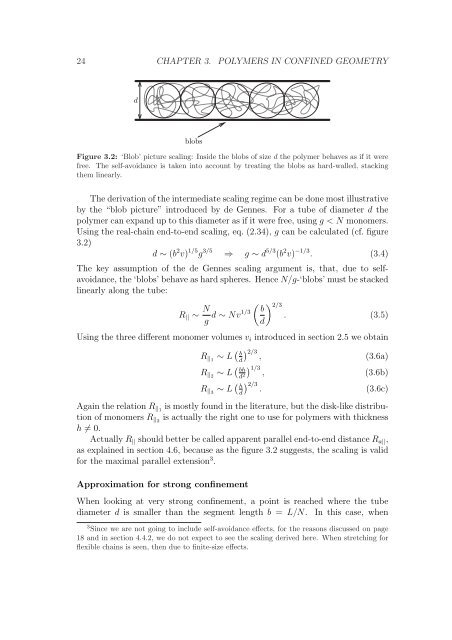Polymers in Confined Geometry.pdf
Polymers in Confined Geometry.pdf
Polymers in Confined Geometry.pdf
Create successful ePaper yourself
Turn your PDF publications into a flip-book with our unique Google optimized e-Paper software.
24 CHAPTER 3. POLYMERS IN CONFINED GEOMETRY<br />
d<br />
blobs<br />
Figure 3.2: ‘Blob’ picture scal<strong>in</strong>g: Inside the blobs of size d the polymer behaves as if it were<br />
free. The self-avoidance is taken <strong>in</strong>to account by treat<strong>in</strong>g the blobs as hard-walled, stack<strong>in</strong>g<br />
them l<strong>in</strong>early.<br />
The derivation of the <strong>in</strong>termediate scal<strong>in</strong>g regime can be done most illustrative<br />
by the “blob picture” <strong>in</strong>troduced by de Gennes. For a tube of diameter d the<br />
polymer can expand up to this diameter as if it were free, us<strong>in</strong>g g < N monomers.<br />
Us<strong>in</strong>g the real-cha<strong>in</strong> end-to-end scal<strong>in</strong>g, eq. (2.34), g can be calculated (cf. figure<br />
3.2)<br />
d ∼ (b 2 v) 1/5 g 3/5 ⇒ g ∼ d 5/3 (b 2 v) −1/3 . (3.4)<br />
The key assumption of the de Gennes scal<strong>in</strong>g argument is, that, due to selfavoidance,<br />
the ‘blobs’ behave as hard spheres. Hence N/g-‘blobs’ must be stacked<br />
l<strong>in</strong>early along the tube:<br />
R|| ∼ N<br />
d ∼ Nv1/3<br />
g<br />
2/3 b<br />
. (3.5)<br />
d<br />
Us<strong>in</strong>g the three different monomer volumes vi <strong>in</strong>troduced <strong>in</strong> section 2.5 we obta<strong>in</strong><br />
R||1 ∼ L <br />
b 2/3<br />
, (3.6a)<br />
d<br />
R||2 ∼ L bh<br />
d2 1/3 , (3.6b)<br />
R||3 ∼ L <br />
h 2/3<br />
. (3.6c)<br />
d<br />
Aga<strong>in</strong> the relation R||1 is mostly found <strong>in</strong> the literature, but the disk-like distribution<br />
of monomers R||2 is actually the right one to use for polymers with thickness<br />
h = 0.<br />
Actually R|| should better be called apparent parallel end-to-end distance Ra||,<br />
as expla<strong>in</strong>ed <strong>in</strong> section 4.6, because as the figure 3.2 suggests, the scal<strong>in</strong>g is valid<br />
for the maximal parallel extension 3 .<br />
Approximation for strong conf<strong>in</strong>ement<br />
When look<strong>in</strong>g at very strong conf<strong>in</strong>ement, a po<strong>in</strong>t is reached where the tube<br />
diameter d is smaller than the segment length b = L/N. In this case, when<br />
3 S<strong>in</strong>ce we are not go<strong>in</strong>g to <strong>in</strong>clude self-avoidance effects, for the reasons discussed on page<br />
18 and <strong>in</strong> section 4.4.2, we do not expect to see the scal<strong>in</strong>g derived here. When stretch<strong>in</strong>g for<br />
flexible cha<strong>in</strong>s is seen, then due to f<strong>in</strong>ite-size effects.













